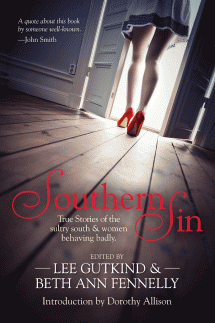There may be other stories in Southern Sin as true to life as “Mad Love: The Ballad of Fred & Allie” by Sonja Livingston. But is there one to compete with the climactic scene in that story, with snow falling in downtown Memphis on a day in January 1892? That’s the day Allie took one last look at Fred and said a gory good-bye.
[jump]
A court eventually declared Allie legally insane and, by August 1st, she was committed to the Tennessee State Insane Asylum in Bolivar. The full story certainly made local and even national news. (“A Tragedy Equal to the Most Morbid Imaginings of Modern French Fiction,” a Memphis paper declared.) And the attention wasn’t only due to what Allie did that snowy day in 1892.
Insane was the verdict, because Allie and Fred had planned to elope and move upriver to St. Louis — Alice (aka Allie) Mitchell disguised as a man; Fred to remain as she was, Frederica (aka Freda, aka Freddie) Ward, both girls from respectable families and students at the Higbee School for Young Ladies (the school only took the best girls from the best families in Memphis) at the corner of Beale and Jessamine.

You be the judge of the insanity verdict after reading “Mad Love,” one of the 23 stories collected in Southern Sin: True Stories of the Sultry South and Women Behaving Badly (due in March from In Fact Books). The anthology is co-edited by Lee Gutkind, founder and editor of Creative Nonfiction magazine (where “Mad Love” first appeared last spring), and Beth Ann Fennelly, director of the MFA program at Ole Miss. But in terms of women behaving badly, even Dorothy Allison would have to hand it to Allie.
As Allison writes in her introduction to Southern Sin, when she was a girl, a favorite pastime within her circle of cousins was playing “worthless sinner,” a competition of sorts to decide the “baddest” among them. “I stole change out of mama’s pocket book,” however, doesn’t quite cut it compared to Allie’s way with a razor.
But surely Allison, who is gay, would sympathize with Allie’s plight. Of Fred, we can’t be so sure why her affections toward Allie took a turn. Fred’s family members’ alarm? Fred’s own second thoughts? We don’t know. Sonja Livingston doesn’t know.
Livingston, who teaches in the MFA program at the University of Memphis and whose areas of interest include personal narrative and creative nonfiction, knows first to keep to the facts. Even so, the “creative” part here she handles beautifully.
“I do base the story on fact, including reporting in local papers and The New York Times. The story was a really big deal, and I didn’t take any liberty with it,” Livingston said recently by phone. “Where I did take liberty is trying to imagine a motive. We have letters from the girls that show they were in love and planning to run away and get married. I don’t know what that felt like, so my imagining what it may have been like, that initial love — that was the creative part.
“I normally write personal essays and memoir, so it’s different for me to imagine somebody else’s life or perspective. But the thing with Allie: I was curious about whether she was this woman gone mad with love — envious and had to murder because she was so frustrated. Or was she just not in a very good place to begin with? That was the challenge but also the exciting part for a writer.”
Thing is, early elements of this story were not, during the period in which it’s set, unusual.
“It was pretty common for girls in boarding schools or elite schools to become ‘chums,'” Livingston said. “In letters from that period, girls often sound romantic. They call each other ‘sweetheart’ and speak like lovers. But I think these girls went a little bit further in their plan to run away to live as man and wife. That was pushing the envelope. Who knows what each of them was thinking and how serious they meant it, but at least they were prepared to do it.”
Livingston first learned of Alice Mitchell and Frederica Ward during a class field trip to Elmwood Cemetery. It’s a trip to introduce and inspire writing students — from inside or outside the South — to the rich storehouse of stories that Livingston, who grew up in Rochester, New York, has discovered living for four years in Memphis.
“Memphis is a great place for writers,” she said. “There are all these stories under the surface. On the outside, Memphis looks kind of gritty — as this place of barbecue and old Cadillacs, and I like those things too. But just underneath all that are tons of stories.
“Being from the North and coming to the South — or maybe it’s just leaving what you know — is good for anybody and especially for writers, because your eyes are opened to things around you. Even my students from Memphis don’t see things that I do. Elmwood: That cemetery alone is full of people and stories — amazing.”
But of Allie and Fred, according to Livingston: “There’s only so much we can really know.” •